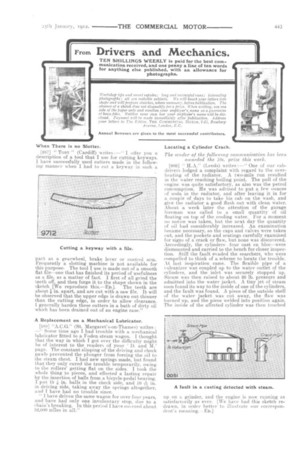From Drivem and Mechanics.
Page 21

If you've noticed an error in this article please click here to report it so we can fix it.
foranything else published, with an allowance for photographs.
tVorkshoft tips and smart repairs ; long and successful runs; interesting photographs; all are suitable subjects. We will knock your letters into shape and will prepare sketehes,where necessary, before Publication. The absence of a sketch does not disqualify for a prize. When writing, use one side of the paper only and mention your employer's,name as a guarantee of bona fides. Neither your own nor your employer's name will be disclosed. Paymeni will be made immediately after publication. Address your letters to The Editor, TEIE COMMERCIAL MOTOR, Rosebery Avenue, London, E.G.
Annual Bonuses are given to the most successful contributors.
When There is no Slotter.
[967] " TOBY " (Cardiff) writes : —" I offer you a description of a tool that I use for cutting keyways. I have successfully used cutters made in the following manner when I had to cut a keyway in such a part as a gearwheel, brake lever or control arm. Frequently a slotting machine is not available for this purpose. The tool I use is made out of a smooth flat file—one that has finished its period of usefulness as a file, as a matter of fact. I first of all grind the teeth off, and then forge it to the shape shown in the sketch [We reproduce this.—En.]. The teeth are about in. apart, and are cut with a saw file. It will be observed that the upper edge is drawn out thinner than the cutting edge, in order to allow clearance, I generally harden these cutters in a bath of dirty oil which has been drained out of an engine case."
A Replacement on a Mechanical Lubricator.
[988] "A.C.G." (St. Margaret's-on-Thames) writes :
Some time ago I had trouble with a mechanical lubricator fitted to a Foden steam wagon. I thought that the way in which I got, over the difficulty might be of interest to the readers of your ' D. and M. page. The constant slipping of the driving and check pawls prevented the plunger from forcing the oil to the steam chest. I had new springs made, but found that they only cured the trouble temporarily, owing to the rollers' getting flat on the sides. I took the whole thing to pieces, and effected a lasting repair by the. insertion of balls from a bicycle-pedal bearing. I put 15 in. balls in the check side, and 10 A in. in driving side, taking away the springs altogether, and I have had no trouble since.
" T have driven the same wagon for over four years, and have had only one involuntary stop, due to a chain's breaking. In this period I have co‘ ered about 52,000 miles in all." Locating a Cylinder Crack.
The sender of the following communication has been awarded the 10s. prize this week.
1989] " ILA." (Leeds) writes :—" One of our cabdrivers lodged a complaint with regard to the overheating of the radiator. A two-mile run resulted in the water reaching boiling point.. The pull of the engine was quite satisfactory, as also was the petrol consumption. He was advised to put a few ounces of soda in the radiator, and after leaving it in for a couple of days to take his cab on the wash, and give the radiator a good flush out with clean water. About a week later the attention of the garage foreman was called to a small quantity of oil floating on top of the cooling water. For a moment no notice was taken, but the next day the quantity of oil had considerably increased. An examination became necessary, so the caps and valves were taken out, and the pockets and scatings carefully examined for signs of a crack or flaw, but none was discovered. Accordingly, the cylinders four cast en bloc—were dismounted and carried to the bench for closer inspection. Still the fault evaded the searchers, who were compelled to think of a scheme to locate the trouble. At last inspiration came. The flexible pipe of a vulcanizer was coupled up to the water outlet of the cylinders, and the inlet was securely stopped up. Steam was then raised to about 20 lb. pressure and admitted into the water jacket. A tiny jet of steam soon found its way to the inside of one of the cylinders, and the fault was found. A piece of the outside shell of the water jacket was cut away, the flaw was burned up, and the piece welded into position again. The inside of the affected cylinder was then touched
up on a grinder, and the engine is now running as satisfactorily as ever. [We have had this sketch redrawn, in order better to illustrate our correspondent's meaning. • --En.]






















